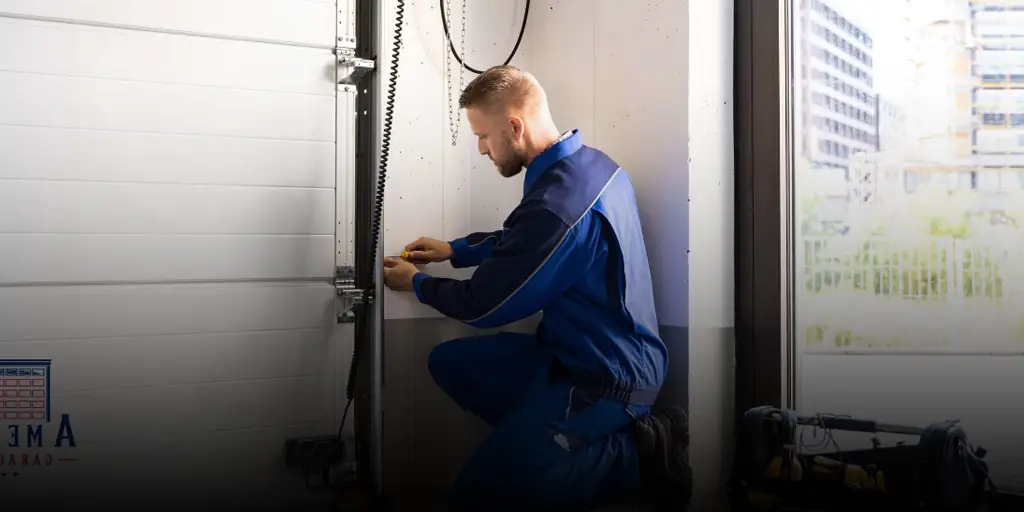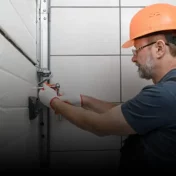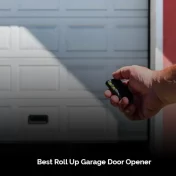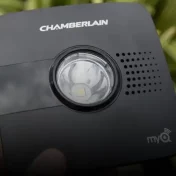Picture this: it’s a rainy evening, and you’re rushing home after a long day at work. All you want is to park your car safely in your garage and unwind.
You press the button on your trusty remote, and like magic, your garage door begins to open. But wait, it suddenly stopshalfway.

You hit the button again, and the door stubbornly refuses to budge. Frustration sets in, and you wonder, “Why Are My Garage Door Sensors Not Lighting Up?”
If you’ve ever found yourself in a scenario like this, you’re not alone. Garage door sensors are the unsung heroes of your daily routine, silently ensuring your safety and convenience.
These small, often overlooked devices play a pivotal role in preventing accidents by detecting obstacles and halting the door’s motion when something is in the way.
In this guide, we’ll not only answer the burning question about why your garage door sensors might not be lighting up but also equip you with the knowledge and practical steps to troubleshoot and fix common sensor issues.
Together, we’ll embark on a journey to regain control over your garage door’s destiny.
So, fasten your seatbelt, or in this case, your toolbelt, as we dive into the world of garage door sensors, shedding light on the mysteries of their malfunctions and unveiling the secrets to their seamless operation.
Understanding Garage Door Sensors
Garage door sensors are crucial components of your automatic garage door system. The most common type of garage door sensor is the photoelectric safety sensor.
These sensors play a vital role in ensuring the safety of your garage door operation by preventing accidents. Since 1993, they have been required by law to be part of automatic garage door kits.
Why Garage Door Sensors Are Essential
Garage door sensors are designed to detect obstacles or obstructions in the path of your garage door.
When functioning correctly, they ensure that your garage door stops closing or opening if they sense an object in the way. This feature prevents accidents, particularly those caused by automatic garage doors.
The Evolution from Mechanical Sensors
Before the popularity of photoelectric safety sensors, garage doors used mechanical sensors. These older sensors triggered the garage door to reverse its motion upon contact with an object.
While these older models may have been easier to troubleshoot, the photoelectric safety sensors offer a significantly safer option due to their ability to detect obstacles in advance.
Common Issues with Garage Door Sensors
When your garage door experiences issues like not closing, stopping, reversing for no apparent reason, or displaying a flashing light on the wall panel, something isn’t working as it should.
Various factors can cause these problems, including broken garage door springs, garage door opener malfunctions, broken door cables, and power outages.
However, one of the most common reasons for such problems is malfunctioning garage door sensors.
Reasons for Malfunctioning Sensors
There are several reasons why garage door sensors may stop working:
- Misalignment: Misalignment of sensors is a common issue, often caused by accidental bumps or vibrations in the garage. You can identify misalignment when one sensor’s red light blinks while the other’s green light remains steady.
- Dirt and Moisture: Sensors, being close to the ground, are susceptible to dirt accumulation, especially in busy garages. Additionally, exposure to moisture or sprinklers near the garage door can lead to signal blockage.
- Wiring Issues: Damage to sensor wires, caused by wear and tear, pests, or exposure to the elements, can lead to sensor malfunctions. Damaged wires may cause the sensor’s light to flash orange instead of red.
- Power Supply Problems: If one or both sensor lights aren’t lighting up, it could be due to power supply issues, such as a power outage in the area, a blown circuit breaker, or the garage door system not being plugged in.
4 Steps to Fix Your Broken Garage Door Sensor
If you’re experiencing problems with your garage door sensors, there are four key steps you can take to troubleshoot and potentially fix the issue:
1. Check if the Garage Door Sensors Are Aligned
To determine if your garage door sensors are correctly aligned, inspect the lights on the sensors.
One sensor should display a steady green light, indicating that it’s sending a light beam, while the other should have a steady red light, signifying it’s receiving the light. If the red light blinks, your sensors are misaligned.
Pro Tip: Misalignment can sometimes be caused by sunlight interfering with the sensor’s light beam. In such cases, shield the sensors from direct sunlight with a piece of cardboard.
2. Check if the Garage Door Sensors Are Dirty
Garage door sensors are prone to accumulating dirt and moisture due to their low position. Regular cleaning is essential to maintain their functionality.
Cleaning Process:
- Use a soft, lint-free, dry cloth to wipe the sensor lenses.
- If cleaning doesn’t resolve the issue, unscrew the metal holders and wipe them dry. Ensure that no moisture is present.
Preventive Measure: To prevent sensor disruption due to dirt, make it a habit to clean the sensor lenses at least once a year.
3. Check the Garage Door Sensors’ Wiring
Inspect the wiring connecting the sensors to the opener’s terminal. Look for any damaged, twisted, or broken wires. Untangle tangled wires and ensure proper connections to the terminal.
Wire Inspection:
- White wires should connect to the white terminal.
- Black and white wires should be connected to the gray terminal.
- Examine for chew marks, tampering, or water damage.
Caution: If the wires are damaged, it’s advisable to hire a professional for replacement to ensure safety.
4. Check the Power Supply
Verify the power supply to the sensors. Ensure there’s no power outage, a blown circuit breaker, or that the garage door system is properly plugged in.
Power Supply Checks:
- If there’s a power outage, the system should operate when power is restored.
- If you suspect a blown circuit breaker, unplug the garage door opener, reset the circuit breaker, and then plug it back in.
By following these four steps, you can often diagnose and fix common garage door sensor issues, ensuring your garage door operates smoothly and safely.
You May Also Enjoy Reading:
- Garage Door Won’t Open With Wall Switch
- Best Garage Door Keypad (Top 5 Picks)
- How to Reset Garage Door Keypad Without Code Liftmaster
How to Bypass Garage Door Sensors
While you’re in the process of troubleshooting and fixing your garage door sensors, there might be situations where you need to temporarily bypass the sensors to use your garage door.
It’s important to do this carefully to avoid accidents, especially if your garage door is malfunctioning.
Important Safety Note: Bypassing the sensors means your garage door can close even if there’s an object or person in the way, potentially causing damage or injury.
It’s crucial to call a professional to fix your garage door sensors as soon as possible. Bypassing should only be a short-term solution.
Steps to Safely Bypass Garage Door Sensors:
- Ideally, bypass the sensors when your garage door is closed. If your door is open and the sensors are malfunctioning, the door might unexpectedly fall closed, which can be dangerous.
- If your door is open and sensors are malfunctioning, prop the door open using a sturdy object like a piece of wood to prevent it from suddenly closing while you disable the sensors.
- Locate the manual release cord, typically red, near the garage door opener motor. This cord allows you to manually open and close the garage door.
- Have a helper hold the garage door in position while you remove the object propping it open. Lower the door slowly and cautiously.
- To open the door, pull down on the manual release cord.
Remember that bypassing garage door sensors should only be a temporary solution until you can get the sensors repaired or replaced.
Safety is a top priority when working with garage doors, and bypassing sensors should be done with care.
Now, let’s explore the steps to replace garage door sensors when troubleshooting and bypassing don’t resolve the issues.
How to Replace Garage Door Sensors
Replacing garage door sensors is a straightforward process that you can typically complete in about 15 to 20 minutes. Before you start, make sure you have the necessary tools ready:
- Step ladder
- Pliers
- Work gloves
- Wire cutters
- Safety glasses
- Blue wire nuts
Steps to Replace Garage Door Sensors:
- Begin by using a step ladder to access the garage door opener’s power cord. Unplug the garage door opener to ensure safety during the replacement process.
- Next, unscrew the wing nuts that secure the old sensors to their brackets. Carefully remove the old sensors.
- Cut the wire attached to the old sensor, leaving about an inch of wire for connecting the new sensor. Ensure you leave enough slack for proper installation. Repeat this process for the second sensor.
- Connect the black and white control wire from the new sensor to the old black and white wire using the blue wire nut. Do the same for the second sensor.
- Proceed to connect the white control wire from the new sensor to the old white wire using another blue wire nut. Repeat this step for the second sensor.
- After successfully connecting the wires, plug the garage door opener back in, and position the new sensors.
- Verify that both sensors are functioning correctly by checking for steady red and green lights.
- To test the sensors, place an object between the two sensors to block the light beam and then try to close the garage door using the remote. The door should not close, and the lights on the motor should blink.
By following these steps, you can replace your garage door sensors and ensure that your garage door operates safely and effectively.
If you’ve attempted troubleshooting, bypassing, and replacing the sensors and are still facing issues, let’s explore what you should do next.
When All Else Fails
If you’ve tried all the troubleshooting steps mentioned earlier, including realigning the sensors, cleaning them, checking the wiring, and ensuring the power supply, but you’re still experiencing issues with your garage door sensors, it may be time to seek professional assistance.
Reasons to Call a Professional:
- Complex Issues: Garage door sensor problems can sometimes be more complicated than they appear. A professional technician has the expertise to diagnose and resolve intricate issues.
- Safety Concerns: Attempting to fix electrical components without the necessary knowledge and skills can be risky. You may expose yourself to electrical hazards or inadvertently worsen the problem.
- Comprehensive Inspection: A professional can conduct a thorough inspection of your entire automatic garage door system, identifying any other components that may need repair or replacement.
- Long-Term Reliability: Professional repairs ensure the long-term reliability and safety of your garage door. This can prevent future malfunctions and potential accidents.
To find a qualified technician, consider reaching out to reputable garage door service providers or seeking recommendations from friends and neighbors who have had similar services performed.
Remember, the safety and functionality of your garage door are paramount, and professional assistance is the best course of action when you’ve exhausted all troubleshooting options.
Conclusion
In this comprehensive guide, we’ve explored the importance of garage door sensors, common issues that may lead to sensor malfunction, and steps to troubleshoot and fix these problems.
We’ve covered the essential steps to realign, clean, check wiring, and verify the power supply of your garage door sensors.
In situations where you need to bypass sensors temporarily, we’ve provided safety instructions to ensure that your garage door can still be used without compromising safety.
If troubleshooting and bypassing don’t resolve the issues, we’ve outlined the process of replacing garage door sensors, emphasizing the importance of safety and proper installation.
Ultimately, when all else fails, seeking professional help is the best approach to ensure your garage door functions reliably and safely.
Remember that regular maintenance and attention to the condition of your garage door sensors can prolong their lifespan and keep your garage door operating smoothly.
Don’t hesitate to address sensor issues promptly to maintain the safety and convenience of your automatic garage door system.
By following the steps outlined in this guide and seeking professional assistance when needed, you can keep your garage door sensors in top-notch condition, ensuring the safe and efficient operation of your garage door.



